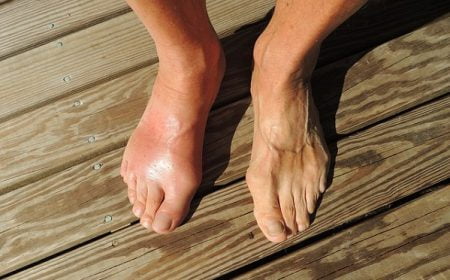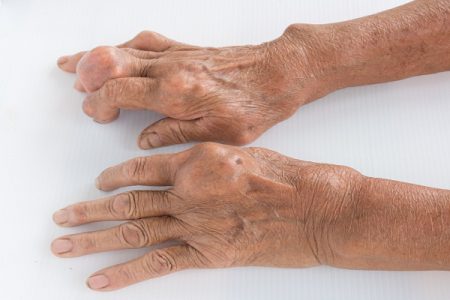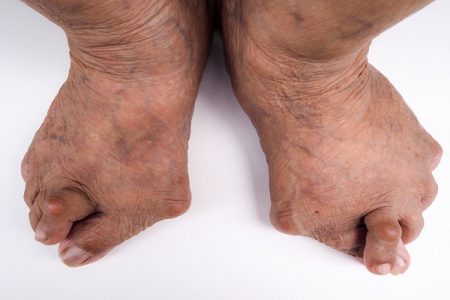All You Need to Know About Gout
- Updated on: Jul 15, 2024
- 9 min Read
By
- Published on Oct 4, 2019


What is gout?
Gout is said to be the most frequently recorded medical illness. It is a kind of arthritis that is caused by a build-up of uric acid crystals in the joints. It occurs due to abnormal metabolism of uric acid.
When purines (a chemical compound found in many foods and drinks) breakdown, uric acid is generated. People suffering from gout either produces too much of uric acid or their kidneys are not capable enough to remove the excess quantity.
The consequences of this deposition of uric acid in joints can cause attacks of painful arthritis, kidney stones, and kidney failure (arising due to kidney filtering tubules blockage with uric acid crystals). Gout usually affects the joints in the big toe. It is also characterized by intense pain, swelling, and stiffness in the joint.
Gout may occur independently (called primary gout) or may be associated with other medical conditions (called secondary gout).
Who gets gout?
Gout is the most common type of inflammatory arthritis. It affects more men (2.7 percent) than women and can affect men of any age. Women have high chances of developing gout after the menopause.
With age, the prevalence of gout increases affecting 15 percent of men and 6 percent of women over the age of 75. Recently, gout has been getting more common because people are living longer (because of advancement in the medical field) and more people are getting overweight.
More: What Are The Various Symptoms And Complications Of Osteoarthritis?
More: What Are The Causes And Risk Factors Of Osteoarthritis?
What are the stages of Gout?
Gout can affect people with many stages. The different stages of gout are discussed below:
Asymptomatic hyperuricemia
Asymptomatic hyperuricemia refers to the period between the inception of the disease and before the first attack. No symptoms are seen at this stage but blood uric acid levels are high and crystals have started forming in the joint.
Acute gout
Acute gout refers to the gout attack which happens when crystals that have deposited in the joints activate and cause episodes of intense pain and swelling in the joint. The pain may subside within three to 10 days. But it is the time to seek medical care as the first attack is followed by many other attacks.
There is no fixed timing for the next attack. It may never occur again for some people while for others it may appear soon. Therefore, a regular monitoring of uric acid levels and an ongoing treatment is important. It is estimated that 60 percent of people who have a gout attack experience a second one within a year and 84 percent of them may have another attack within three years.
Interval gout
Interval gout refers to the time period between two attacks. In this stage, the person may not experience any symptoms but gout isn’t gone completely. The person may have some low-level inflammation that may be damaging joints. This is the time the patient needs to take steps in order to manage gout by making certain lifestyle changes so that future attacks can be prevented.
Chronic gout
As the name suggests, chronic gout occurs for a long period. It usually develops in people whose uric acid levels remain high over a number of years. For such people, attacks become more frequent and the pain remains constant.
Joint damage can lead to a loss of mobility. This stage can be prevented if proper management and treatment is practiced.
What are the symptoms of gout?
The signs and symptoms of gout always occur suddenly, more often at night. They may include:
Intense joint pain
The pain is severe and intense (so much that even a bed sheet on the toe causes severe pain) within the first four to twelve hours and the most common joint involved is the big toe, but it can occur in any joint.
Other commonly affected joints are:
- Ankles
- Knees
- Elbows
- Wrists
- Fingers
Lingering discomfort
After the pain subsides, discomfort may be experienced in some joints for a few days to a few weeks.
Inflammation and redness
The affected joints become swollen, tender, warm and red.
Limited range of motion
As gout progresses, the patient may not be able to move the joints normally. He or she may also experience pain and discomfort during the movement.
Presence of tophi
A tophus is a nodule of uric crystals that deposits under the skin when the condition goes out of control. It can be commonly found on the elbows, upper ear cartilage, and on the surface of other joints. Presence of tophi indicates that the body is overloaded with uric acid and the level has been high for many years.
More: What Is A Bone Density Test For Osteoporosis (Bone Mineral Density, BMD Test)?
Gout Causes: What are the causes of gout? Why do people get gout?
Increased levels of uric acid is the main cause of gout.
Uric acid is a waste product created during the breakdown of purines (naturally occurring substances found in foods such as liver, mushrooms, mackerel and dried beans). This waste product is usually cleaned from the blood by the kidneys and passes out of the body with urine. But sometimes, the uric acid levels increase and give rise to gout disease.
High levels of uric acid can accumulate in the body due to two factors:
Problem with kidneys
The one reason for the accumulation of uric acid in the body (cause of gout) can be an incapable kidney. The kidneys are not effective enough to excrete all the urine out of the blood.
Hyperuricemia
Hyperuricemia can be another gout cause. It refers to the increased production of uric acid from purines. The increased production leads to high concentration of uric acid in the blood and that convert the acid into urate crystals.
These crystals then accumulate around the joints and soft tissues giving rise to inflammation and the painful symptoms of gout.
What are the risk factors for gout?
Gout occurs when the level of uric acid increases in the body. Factors that increase the uric acid level in your body and that serve as risk factors for gout may include such as:
Diet
Eating a diet containing high levels of purines (like red meat and seafood) and drinking beverages sweetened with fruit sugar (fructose) can increase the levels of uric acid and is considered a risk factor of gout.
Alcohol consumption
Consuming alcohol, especially of beer, also increases the risk of gout.
Obesity
Being overweight increases the risk of gout because an obese body produces more uric acid and the kidneys will have a more difficult time eliminating uric acid.
Medical conditions
Certain diseases and conditions increase the risk of gout. These may include:
- Untreated high blood pressure
- Chronic conditions like diabetes
- Heart and kidney diseases
Certain medications
Certain medications if taken regularly can increase the risk of gout. Such medications include:
- Thiazide diuretics used for the treatment of hypertension
- Low-dose aspirin
- Anti-rejection drugs prescribed for people who have undergone an organ transplant
Family history
A person’s risk of getting gout increases if other members of his family have had gout in the past.
Age and sex
Men are more at risk of developing gout than women because women tend to have lower uric acid levels.
Men are also more likely to develop gout in their early age such as between the ages of 30 and 50 while women generally develop signs and symptoms after menopause.
Recent surgery
A recent surgery or even a trauma increases the risk of developing a gout attack to much higher levels.
More: Bone Cyst: Types, Symptoms, Causes, Diagnosis, Treatment, and Surgery
Diagnosis of Gout: How is gout diagnosed?
Gout can be tricky to diagnose because its symptoms are similar to some other conditions. Hyperuricemia is the condition that occurs in the majority of gout patients but it may not be present during an attack.
Most people with hyperuricemia do not develop gout. Diagnosis of gout can be made by carrying out certain tests which may include:
Tests and methods for diagnosing gout
Physical examination
The doctor may look out for the inflammation and other symptoms of the disease.
Joint fluid test
In this test, a needle is used to draw some fluid from the affected joint. When the fluid is examined under a microscope, urate crystals can be seen which helps in gout diagnosis.
Blood test
Doctors recommend a blood test to measure the levels of uric acid and creatinine in the blood. But blood tests alone cannot give 100 percent assurance of the diagnosis of gout because sometimes blood test results can be misleading.
It is seen that some people have high uric acid levels, but never experience gout while some other people show signs and symptoms of gout, but don’t have high levels of uric acid in their blood.
X-ray imaging
X-rays of the affected joints are taken in order to rule out other causes of joint inflammation and pain and help in gout diagnosis.
Ultrasound
Musculoskeletal ultrasound is helpful in detecting urate crystals in a joint or in a tophus.
Dual-energy CT scan
Dual-energy CT scan is done when the joint is not acutely inflamed but the doctor needs to detect the presence of urate crystals in a joint. This test is quite expensive and is not widely available which restricts its usage. Therefore, it is not generally done for the diagnosis of gout disease.
Treating Gout Disease: What are the treatment options available for gout?
Treatment of gout includes a combination approach of medications and lifestyle changes. Gout treatment can proceed as follows:
Treating an acute gout attack
The pain and swelling of a gout attack can be controlled in the following ways:
- Take an anti-inflammatory medication as soon as the attack occurs
- Elevate the joint and soothe it with ice
- Drink plenty of natural fluids (no alcohol or sweet sodas)
- Call your doctor and ask for the medical help
- Relax and avoid stress (it can aggravate the symptoms)
The gout attack normally resolves within 7-10 days and then disappears completely. But the first 36 hours are typically the worst and immediate action needs to be taken. You should consult with the doctor after the attack also regularly to control uric acid levels and prevent future gout attacks.
Medications for treating an acute gout attack
Here are the medications used to treat an acute gout attack:
Nonsteroidal anti-inflammatory drugs (NSAIDs)
These medications are frequently used to relieve the joints pain and swelling of an acute gout episode. They can also shorten the attack but for that, these drugs should be taken in the first 24 hours.
Corticosteroids
Corticosteroids (such as prednisone) can be taken orally as a tablet or directly injected into the inflamed joint to relieve the pain and swelling of an acute gout attack.
These medications are sometimes injected systemically also if requirement arises, when there is no positive response to other medications or if many joints are affected. Corticosteroids usually show their effect within 24 hours of taking them and are used in the treatment of gout.
Colchicine
Colchicine is derived from a plant and has been used for many years. It helps to relieve the pain and swelling of acute attacks. Side effects of colchicine may include diarrhea, nausea and abdominal cramp. It shows its effectiveness if taken at the first signs of a gout attack.
Reducing Uric Acid Levels
These medications are given to prevent gout attacks and keep the condition from becoming chronic. These medications are given after the attack is over because their use during the attack can worsen the condition.
These medications are taken with utmost care since their intake drops the uric acid level which shifts the uric crystals in the joint. This may initiate another attack. But the only way to prevent the future attack is to stick to the treatment plan. The medications to reduce uric acid levels are:
Allopurinol
It often starts with a low dose and then gradually its doze is increased. Skin rash and stomach upset are some side effects of this medicine. Stomach problems usually go away soon because the body adjusts to the drug.
Febuxostat
This is given to people who develop side effects from allopurinol or have kidney disease. Initially, this medicine is also given in low doses and increased if the uric acid levels remain high. Side effects can include nausea and joint or muscle pain.
Probenecid
These medicines act on the kidneys to help the body eliminate uric acid. The medication is taken daily and is combined with antibiotics to boost effectiveness. Common side effects include kidney stones, nausea, skin rash, stomach getting upset and headaches.
Lesinurad
It is an oral drug that is combined with a xanthine oxidase inhibitor (XOI), such as allopurinol or febuxostat (for people whose gout is not controlled by optimally-dosed XOIs alone) for the treatment of gout.
Headache, flu symptoms, gastroesophageal reflux disease (GERD), kidney-related side effects and kidney stones are some of the side effects experienced when these medicines are taken.
Pegloticase
This is the last option in gout treatment and is given only when standard medications are unable to lower the uric acid level (refractory chronic gout). Pegloticase reduces uric acid more quickly and effectively to much lower levels than other medications.
The drug is given twice a week by intravenous (IV) infusion. Gout flares, nausea, bruising, sore throat, constipation, chest pain and vomiting are some of the side effects of the medicine.
Treatment of joint damage
In some serious cases, the patient comes to know about the disease after gout has already caused joint damage. For such situations, the treatment of gout will be the same as for osteoarthritis, which may include:
- Losing weight if you are overweight
- Regular exercise (muscle strengthening and aerobic exercise)
- Reducing strain on the affected joint
- Painkillers (paracetamol and codeine)
- NSAIDs
- Anti-inflammatory creams and gels
- Topical capsaicin cream
- Steroid injections into the painful joint
- Surgery, including joint replacement
Prevention of gout: How can gout be prevented?
Certain lifestyles and dietary guidelines if followed with consistent efforts can be helpful to prevent gout from occurring. You can follow these steps for the prevention of gout disease.
- Maintain a high fluid intake of around 2 to 4 litres a day
- Maintain a healthy body weight
- Try to eat low purine diet which may include:
- Refined cereals like bread, pasta and cakes
- Milk and milk products and eggs
- Lettuce, tomatoes and green vegetables
- Cream and soups without meat stock
- Water, fruit juice and carbonated drinks
- Peanut butter, fruits and nuts
- Avoid foods that are high in purine which may include:
- All organ meats (such as liver), meat extracts and gravy
- Yeasts, and yeast extracts (such as beer, and alcoholic beverages)
- Asparagus, spinach, beans, peas, lentils, oatmeal, cauliflower and mushrooms
- Take all of your medications for hyperuricemia as directed
- Avoid caffein
- Avoid alcohol
Gout Complications: What are the complications of gout?
If left untreated for a longer time, gout can develop into more serious conditions. Common complications of gout are:
Kidney stones
Urate crystals may collect in the urinary tract of people with gout and may lead to kidney stones.
Recurrent gout
Some people experience only one flare-up in the disease duration, while others may have regular recurrences. Sometimes, several instances of attacks occur in a year. This situation may cause gradual damage to the joints and surrounding tissues and can lead to a serious gout complication.
Advanced gout
Untreated gout may cause urate crystals to deposit under the skin in nodules that are called tophi. These nodules can develop in several areas such as the fingers, hands, feet, elbows or along the backs of the ankles.
Tophi usually do not cause pain, but they can bother the gout patient during gout attacks by becoming swollen and tender.
Various other gout complications may also occur depending on the severity of the disease in a patient.











